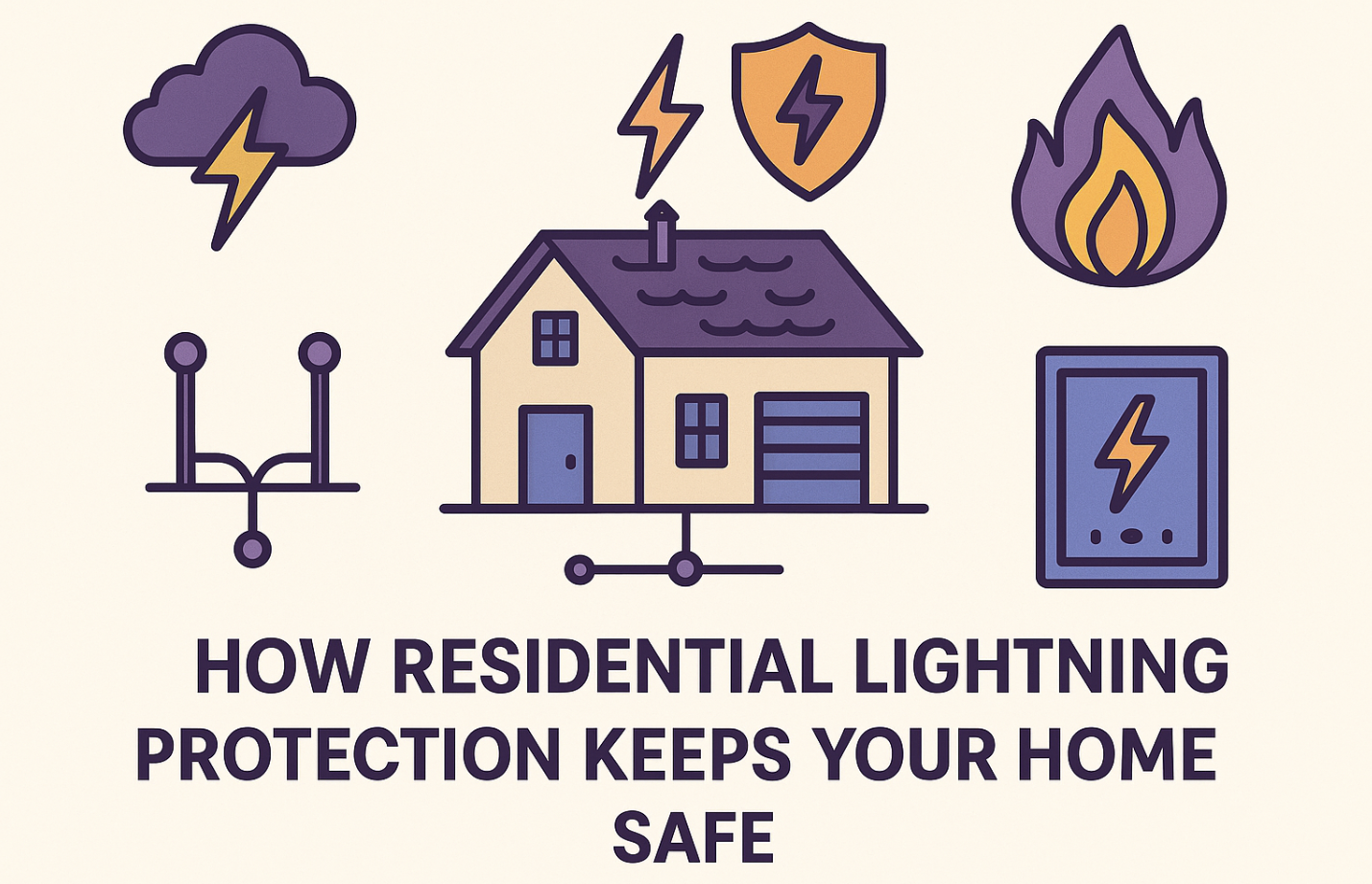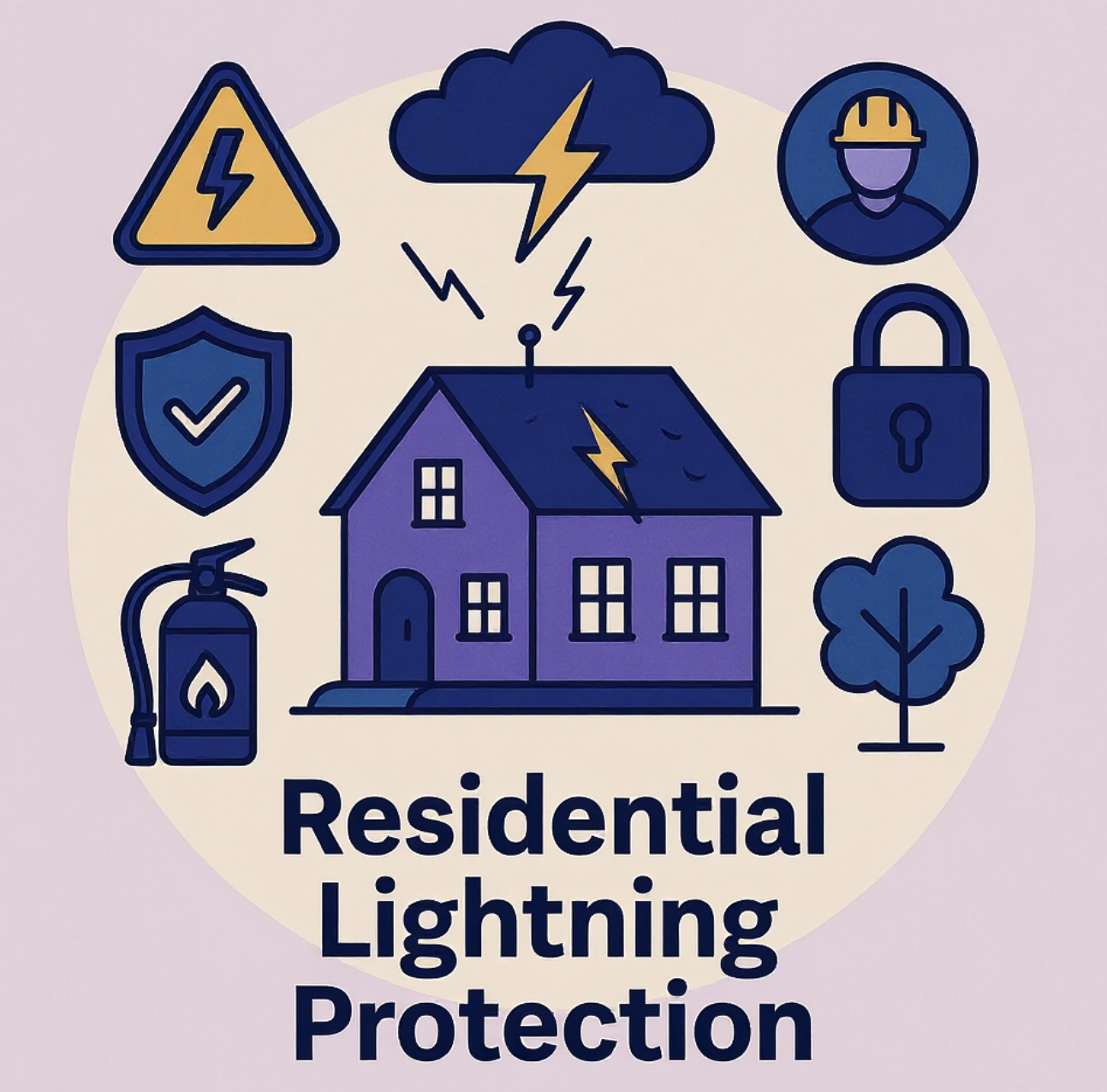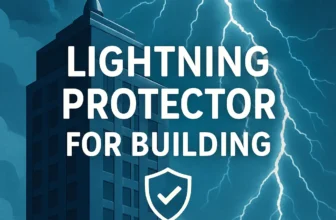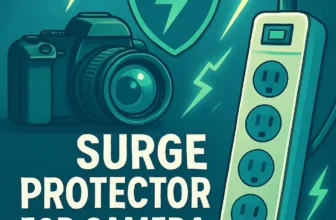Published By: Marc Edwards | Last updated on September 20, 2025 and reviewed by Editorial Team

Lightning is one of nature’s most powerful forces, capable of causing devastating damage to your home in seconds. Without proper safeguards, a single strike can ignite fires, destroy electrical systems, and even compromise your home’s structure. Residential lightning protection offers a reliable solution to this threat. It intercepts the lightning’s energy and redirects it safely into the ground, keeping your home and loved ones out of harm’s way.
Protecting your property isn’t just about avoiding repairs—it’s about ensuring peace of mind every time a storm rolls in. In this post, we will touch on how the lightning protection system works and the cost involved when implementing it.
Why Residential Lightning Protection Matters
Risks of Lightning Strikes
Fire and structural damage
Lightning strikes are not just dramatic; they are incredibly destructive. A single strike can reach temperatures of up to 50,000 degrees Fahrenheit, which is five times hotter than the surface of the sun. This extreme heat can ignite flammable materials in your home, leading to devastating fires.
According to the National Fire Protection Association, lightning-caused fires result in over $451 million in property losses annually in the U.S. The structural damage from a strike can also compromise your home’s integrity, leaving you with costly repairs and a weakened foundation. A residential lightning protection system minimizes these risks by intercepting the strike and safely channeling its energy into the ground. This prevents the heat and force of the lightning from wreaking havoc on your home.
Electrical surges and appliance failure
Lightning doesn’t just threaten your home’s structure; it can also destroy your electrical systems. When lightning strikes, it often causes powerful electrical surges that travel through your wiring. These surges can fry your appliances, damage your electronics, and even start electrical fires.
A lightning protection system safeguards your home’s electrical components. Lightning rods intercept the strike, conductors transfer the energy, and grounding rods disperse it safely into the earth. Surge protectors installed at your electrical panel add another layer of defense, redirecting excess energy away from your appliances. This coordinated system ensures your home remains functional and your devices stay protected.
Benefits of Protection Systems
Preventing costly repairs
Repairing the damage caused by lightning can be expensive. From fixing structural issues to replacing fried appliances, the costs add up quickly. A lightning protection system acts as a shield, reducing the likelihood of damage and saving you thousands of dollars in repair bills. It also protects your investment in your home and electronics, ensuring they remain safe during storms.
Homeowners with these systems may even qualify for insurance discounts, as the reduced risk of lightning damage lowers the likelihood of filing claims. This makes installing a residential lightning protection system a smart financial decision.
Ensuring family safety
Your family’s safety is priceless. Lightning strikes can cause fires, electrical shocks, and other hazards that put your loved ones at risk. A properly installed lightning protection system gives you peace of mind during thunderstorms.
Lightning rods, grounding systems, and surge protectors work together to redirect dangerous energy away from your home, keeping your family safe. With this system in place, you can rest easy knowing your home is prepared to handle even the fiercest storms. Protecting your family and property from lightning is not just a precaution—it’s a necessity.
Key Components of Residential Lightning Protection
Lightning Rods
Function and placement
Lightning rods are the first line of defense in protecting your home from lightning strikes. These devices, installed on your roof, act as strike termination points. When lightning targets your home, the rod intercepts the electrical charge and directs it safely into the protection system. Without this critical component, the immense energy from a strike could directly hit your home, causing fires or structural damage.
The materials used in lightning rods are carefully chosen for their conductivity. Copper and aluminum are the most common options. Copper offers superior electrical conductivity and mechanical strength, making it ideal for handling high-energy strikes.
Aluminum, while slightly less conductive, is a lightweight alternative that performs well when sized appropriately.
Proper placement is essential for maximum effectiveness. Lightning rods should be installed at the highest points of your home, such as chimneys, roof ridges, or towers, ensuring they can intercept strikes before they reach vulnerable areas.
Ground Rods
Energy dissipation
Ground rods play a vital role in safely dispersing the energy captured by lightning rods. Once the electrical charge is intercepted, it travels through the system and reaches the ground rods, which release the energy into the earth. This process prevents the energy from lingering in your home, where it could cause fires or electrical damage.
Installing ground rods requires precision. First, you must select a location free of underground utilities. Then, drive the rod vertically into the ground, ensuring it reaches a depth of at least 8 feet to access moist soil for better conductivity.
Secure the rod to prevent movement, and attach the grounding conductor using a clamp for a low-resistance connection. Finally, connect the conductor to the main grounding system and test the installation to ensure it meets safety standards. Properly installed ground rods ensure the energy from a lightning strike dissipates harmlessly, protecting your home and family.
Copper Cables
Safe energy transfer
Copper cables are the unsung heroes of your lightning protection system. These conductors create a seamless pathway for the electrical charge to travel from the lightning rod to the ground rods. Their high conductivity and durability make them the perfect choice for this task.
When lightning strikes, the energy must move quickly and safely through the system. Copper cables handle this transfer efficiently, minimizing resistance and reducing the risk of overheating. They are designed to withstand the immense energy of a lightning strike, ensuring the system remains intact and functional. Without these cables, the energy could scatter unpredictably, increasing the likelihood of damage.
A well-designed lightning protection system relies on the coordination of its components. Lightning rods, ground rods, and copper cables work together to create a low-resistance path for the electrical charge. Such a combination ensures your home stays safe during even the most severe storms.
Surge Protectors
Voltage spike protection
Surge protectors are essential components of your home’s lightning protection system. They shield your electrical devices from dangerous voltage spikes caused by lightning strikes. Without them, the sudden surge of electricity could overwhelm your appliances, leading to costly damage or even complete failure. Installing surge protection devices ensures your home’s electronics remain safe, even during the most intense storms.
You have two main types of surge protectors to consider:
-
Whole-home surge protectors: These devices are installed at your electrical panel. They provide comprehensive protection by blocking voltage spikes before they reach your home’s wiring. This type of surge protector is ideal for safeguarding your entire electrical system, including hardwired appliances like HVAC units and water heaters.
-
Point-of-use surge protectors: These are the power strips you plug into individual outlets. They offer localized protection for specific devices, such as your computer, television, or gaming console. While they don’t cover your entire home, they add an extra layer of defense for your most valuable electronics.
Combining both types of surge protectors gives you the best results. Whole-home surge protectors handle large voltage spikes, while point-of-use devices protect sensitive electronics from smaller surges. Together, they create a robust barrier against electrical damage.
Surge protection devices work by diverting excess electricity away from your appliances. When a lightning strike causes a voltage spike, the surge protector detects the excess energy and redirects it to the ground. This process happens in milliseconds, ensuring your devices remain unharmed. Investing in surge protectors not only saves you money on repairs but also extends the lifespan of your electronics.
Lightning strikes are unpredictable, and the damage they cause can be devastating. With surge protection devices in place, you can rest easy knowing your home and appliances are prepared for any storm.
Tip: Regularly inspect your surge protectors to ensure they’re functioning correctly. Replace them immediately if you notice any signs of wear or damage.
How Residential Lightning Protection Systems Work
Energy Pathway
From interception to grounding
A residential lightning protection system creates a clear and safe pathway for lightning energy to travel. This pathway ensures your home remains unharmed during a storm. The process begins with lightning rods, which act as the primary target for lightning strikes. These rods are strategically placed at the highest points of your home, such as the roof or chimney.
When lightning strikes, the rod intercepts the electrical current, preventing it from hitting vulnerable areas of your home. Once intercepted, the energy flows through conductors. These conductors are specially designed to handle the immense power of a lightning strike. They guide the electrical current safely from the lightning rod to the ground rods. Ground rods, buried deep in the earth, complete the pathway. They disperse the energy into the ground, where it can no longer pose a threat to your home or family.
This seamless energy pathway is the backbone of your lightning protection system. Each component works together to ensure the energy is intercepted, transferred, and dissipated without causing harm. By directing the energy away from your home, the system protects your property, electronics, and loved ones from the destructive force of lightning.
Component Coordination
Seamless energy transfer
The effectiveness of a lightning protection system depends on the coordination of its components. Each part must work in harmony to create a seamless energy transfer process. Lightning rods, conductors, and ground rods form a unified system that channels energy safely away from your home.
Lightning rods serve as the first line of defense, capturing the strike. Conductors then take over, transferring the energy quickly and efficiently. These conductors are made from high-quality materials like copper, which ensures minimal resistance and prevents overheating. Finally, ground rods disperse the energy into the earth, completing the process.
Surge protectors also play a crucial role in this coordination. They shield your home’s electrical system from voltage spikes caused by lightning. By redirecting excess energy, surge protectors prevent damage to your appliances and electronics. Together, these components create a robust defense against lightning strikes. This coordination ensures that the energy flows smoothly from interception to grounding.
Without it, the energy could scatter unpredictably, increasing the risk of damage. A well-designed system eliminates this risk, providing you with peace of mind during even the most severe storms.
Addressing Misconceptions About Lightning Protection
“Lightning rods attract lightning”
Many people believe that installing a lightning rod will make their home a target for strikes. This is a myth. Lightning rods don’t attract lightning; they simply provide a safe path for the energy to travel if a strike occurs. Lightning naturally seeks the shortest route to the ground. Without a rod, your home’s roof, chimney, or other structures could become that pathway, leading to severe damage.
A lightning rod acts as a safeguard, intercepting the strike and directing the energy into the ground. It doesn’t increase the likelihood of a strike but ensures your home is protected if one happens. Modern lightning rods are more advanced than ever, making them a crucial part of any residential protection system.
Fact Check: Metal doesn’t attract lightning. It conducts electricity, which is why it’s used in protection systems.
“Urban homes are safe from lightning”
You might think living in a city shields you from lightning strikes. This assumption is incorrect. While urban areas may have tall buildings, these structures don’t eliminate the risk for nearby homes.
In fact, tall buildings often require their own lightning protection systems because they are at higher risk.
Trees in urban neighborhoods also don’t offer protection. Instead, they can increase the danger. If lightning strikes a tree near your home, the energy can travel through the ground or jump to your property, causing damage. Lightning doesn’t discriminate between rural and urban areas. Your home’s location doesn’t guarantee safety. Installing a residential lightning protection system ensures your property is prepared, no matter where you live.
“Surge protectors are sufficient”
Surge protectors are valuable tools, but they can’t handle the immense power of a direct lightning strike. A single bolt can carry up to one billion volts, far exceeding the capacity of standard surge protectors. These devices are designed to manage everyday power surges, not the extreme energy of lightning.
Here’s why surge protectors alone aren’t enough:
-
They can’t fully protect against direct strikes.
-
They work well for common voltage spikes but fail against the extreme voltages of lightning.
-
A direct strike can overwhelm even the best surge protector, leaving your home vulnerable.
A complete lightning protection system includes lightning rods, conductors, ground rods, and surge protectors. Together, these components create a comprehensive defense. Relying solely on surge protectors leaves gaps in your home’s safety.
Practical Tips for Homeowners
Assessing Your Home’s Risk
Factors influencing vulnerability
Understanding your home’s vulnerability to lightning strikes is the first step in protecting it. Several factors can increase your risk. Homes located in regions with frequent thunderstorms face a higher likelihood of strikes. If your property sits on elevated terrain or near open spaces like fields or water bodies, it becomes an easier target for lightning. Tall structures, such as trees or antennas near your home, can also increase the risk by acting as natural conductors.
Evaluate your home’s construction materials as well. Metal roofs and chimneys can conduct electricity, while wood and other flammable materials are more prone to fire damage. If your home has outdated wiring or lacks surge protection, it’s even more susceptible to electrical surges caused by lightning. Assessing these factors helps you determine the level of protection your home needs.
A professional risk assessment can provide a detailed analysis, ensuring you take the right steps to safeguard your property.
Choosing a System
Working with certified professionals
Selecting the right lightning protection system requires expertise. Working with certified professionals ensures your system meets safety standards and functions effectively. Look for providers certified by reputable organizations like the Lightning Protection Institute (LPI). Their inspection program, LPI-IP, guarantees that installations are completed by qualified personnel and independently inspected for safety.
To help you choose the right provider, here’s a quick guide to certifications:
|
Description |
|
|---|---|
|
UL Solutions Lightning Protection Journeyman Certification |
Covers requirements for ordinary structures from UL 96A and NFPA 780. |
|
UL Solutions Lightning Protection Master Certification |
Includes additional requirements for non-ordinary structures like flammables. |
Certified professionals understand the complexities of lightning protection systems. They ensure proper placement of components like lightning rods and ground rods, creating a seamless pathway for energy transfer.
Avoid DIY installations, as they often fail to meet safety standards and leave your home vulnerable.
Maintenance and Inspections
Ensuring system functionality
Regular maintenance keeps your lightning protection system in top condition. Annual visual inspections are essential to identify any visible damage or loose connections. In areas with severe weather, consider semi-annual inspections to address potential issues caused by climatic changes.
Complete inspections should occur every 3-5 years to ensure all components function correctly. Critical systems, such as those in homes with sensitive electronics or high-risk locations, may require inspections every 1-3 years.
After severe storms or home renovations, schedule an immediate inspection to check for damage or disruptions in the system.
During inspections, focus on key components like air terminals, cable connections, grounding electrodes, and surge protection devices. A certified specialist should handle repairs and follow-up inspections to ensure compliance with safety standards.
Here’s a checklist for effective maintenance:
-
Inspect all components annually or semi-annually.
-
Conduct complete inspections every 3-5 years.
-
Check for damage after severe weather or home alterations.
-
Ensure all connections are secure and components are intact.
Regular maintenance not only extends the lifespan of your system but also ensures your home remains protected against lightning strikes.
The Cost and Value of Residential Lightning Protection
Installation Costs
Factors affecting pricing
Installing a residential lightning protection system is an investment in your home’s safety. The cost varies based on several factors, allowing you to tailor the system to your specific needs and budget.
|
Factor |
Description |
|---|---|
|
Materials |
Account for 30% to 50% of the total cost. |
|
Labor |
Typically ranges from $35 to $50 per hour. |
|
System Complexity |
Simple systems cost less than complex ones. |
|
Roof Condition |
Hard-to-reach areas increase installation expenses. |
|
Location |
Regional demand can influence pricing. |
The materials used, such as copper cables and lightning rods, significantly impact the overall cost. Labor costs depend on the complexity of the installation and the condition of your roof.
For example, steep or hard-to-reach roofs may require additional time and effort, increasing the expense.
Here’s a breakdown of typical costs:
-
Lightning rods: $50 to $200 each.
-
Installation of lightning rods: $500 to $2,500.
-
Grounding systems: $100 to $500.
-
Surge protection for larger homes: $300 to $1,000.
-
Labor: $50 to $150 per hour.
-
Permits and inspections: $50 to $200.
While the upfront costs may seem significant, they pale in comparison to the potential financial losses from lightning damage. A well-installed system protects your home and provides long-term value.
Long-Term Benefits
Peace of mind and damage prevention
Investing in a lightning protection system offers more than just physical safety—it brings peace of mind. Knowing your home and loved ones are protected during storms allows you to focus on what matters most.
These systems create a low-resistance path for electrical currents, preventing fires and structural damage. They also shield your appliances from power surges, saving you from costly repairs or replacements. By redirecting lightning’s energy safely into the ground, the system ensures your home remains intact, even during severe weather.
Here’s how a lightning protection system enhances your quality of life:
-
Keeps your family and property safe during storms.
-
Prevents financial losses from fires, structural damage, and appliance failures.
-
Reduces stress and anxiety caused by unpredictable weather.
The return on investment becomes clear when you consider the long-term savings. Homes with certified systems often qualify for lower insurance premiums, thanks to their reduced risk profile. In areas prone to thunderstorms, this can lead to significant savings over time. Additionally, fewer disputes and quicker resolutions for lightning-related insurance claims add to the system’s value.
A lightning protection system doesn’t just protect your home—it enhances its longevity and value. With this safeguard in place, you can weather any storm with confidence.
Protecting your home and loved ones from lightning strikes is a worthy investment. A residential lightning protection system acts as a safeguard, intercepting lightning and directing its energy harmlessly away from your property. By doing so, it prevents devastating fires, shields your electrical devices from damage, and saves you from costly repairs down the line. Although the initial installation cost may seem significant, the long-term advantages and peace of mind it provides make it a worthwhile expenditure.
|
Pros |
Cons |
|---|---|
|
Keep homes safe from lightning strikes |
Expensive to install |
|
Prevent fires and electrical hazards |
Visible outside of the building |
|
Protect electric systems and devices |
Require regular inspections and maintenance |
|
Can qualify for insurance discounts |
|
To maximize safety, consider these steps:
-
Ask a qualified electrician to inspect your grounding system.
-
Use point-of-use surge protection devices for appliances.
-
Install a whole-house surge protection system.
Take action today to ensure your home is ready for the next storm.
FAQ
What is a residential lightning protection system?
A residential lightning protection system safeguards your home by intercepting lightning strikes and safely directing the energy into the ground. It prevents fires, electrical surges, and structural damage, ensuring your family and property stay safe during storms.
Do lightning rods attract lightning?
No, lightning rods don’t attract lightning. They provide a safe path for the energy if a strike occurs. Without a rod, your home could become the target, leading to severe damage.
Can I install a lightning protection system myself?
DIY installation isn’t recommended. Certified professionals ensure proper placement and compliance with safety standards. Incorrect installation can leave your home vulnerable to lightning damage.
How often should I inspect my lightning protection system?
Inspect your system annually or after severe storms. Complete inspections every 3-5 years ensure all components function correctly. Regular maintenance keeps your system reliable and effective.
Are surge protectors enough to protect my home?
Surge protectors alone can’t handle the immense energy of a lightning strike. They work best as part of a complete system that includes lightning rods, conductors, and ground rods.
Does a lightning protection system increase home value?
Yes, it enhances safety and reduces risks, which can make your home more appealing to buyers. Some insurance providers also offer discounts for homes with certified systems.
How much does a lightning protection system cost?
Costs vary based on materials, labor, and system complexity. Expect to pay $500 to $2,500 for installation. While the upfront cost may seem high, it’s a worthwhile investment in safety and peace of mind.
Is lightning protection necessary in urban areas?
Yes, urban homes are still at risk. Tall buildings and trees nearby don’t eliminate the danger. A lightning protection system ensures your home stays safe, no matter where you live.








